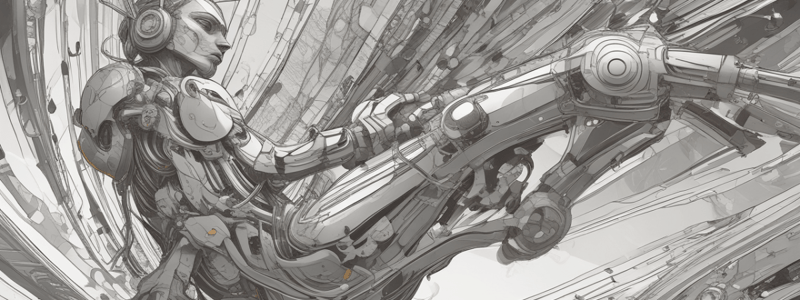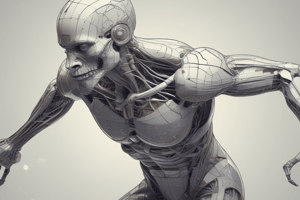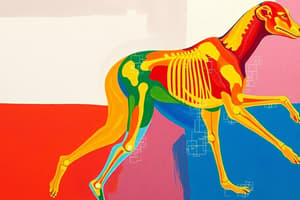Podcast
Questions and Answers
What type of motion occurs between the articular surfaces of joints?
What type of motion occurs between the articular surfaces of joints?
- Arthrokinematic movement (correct)
- Accessory joint movement
- Passive kinesitherapy
- Osteokinematic movement
Which of the following is NOT a type of arthrokinematic movement?
Which of the following is NOT a type of arthrokinematic movement?
- Spin
- Glide
- Traction
- Osteokinematic (correct)
What is the result of a concave surface moving on a convex surface?
What is the result of a concave surface moving on a convex surface?
- Rolling and gliding in opposite directions
- Only rolling occurs
- Only gliding occurs
- Rolling and gliding in the same direction (correct)
What is the relationship between joint congruency and arthrokinematic movement?
What is the relationship between joint congruency and arthrokinematic movement?
What is a combination of various arthrokinematic movements during osteokinematic motion?
What is a combination of various arthrokinematic movements during osteokinematic motion?
When a convex surface moves on a concave surface, what occurs?
When a convex surface moves on a concave surface, what occurs?
What does kinematics describe?
What does kinematics describe?
What type of motion is described as a linear motion in which all parts of a rigid body move parallel to and in the same direction as every other part of the body?
What type of motion is described as a linear motion in which all parts of a rigid body move parallel to and in the same direction as every other part of the body?
What is the term for the motion that occurs between the articular surfaces of joints?
What is the term for the motion that occurs between the articular surfaces of joints?
What is the direction of rolling in relation to osteokinematic motion?
What is the direction of rolling in relation to osteokinematic motion?
What are the three cardinal planes of the body?
What are the three cardinal planes of the body?
What type of joint is characterized by a single axis of rotation?
What type of joint is characterized by a single axis of rotation?
What is the term for the degrees of freedom of each joint?
What is the term for the degrees of freedom of each joint?
What is an open kinetic chain?
What is an open kinetic chain?
What is the movement allowed in a pivot joint?
What is the movement allowed in a pivot joint?
What is the term for the motion of bones relative to the three cardinal planes of the body?
What is the term for the motion of bones relative to the three cardinal planes of the body?
What is the significance of the convex-concave rule in artrokinematics?
What is the significance of the convex-concave rule in artrokinematics?
What is the clinical relevance of artrokinematic principles?
What is the clinical relevance of artrokinematic principles?
What is the axis around which all points in a body rotate in a circular path?
What is the axis around which all points in a body rotate in a circular path?
What type of joint is characterized by three axes of rotation?
What type of joint is characterized by three axes of rotation?
What is the characteristic of a plane joint?
What is the characteristic of a plane joint?
What is the effect of OKC vs CKC motion on the convex-concave rule?
What is the effect of OKC vs CKC motion on the convex-concave rule?
In which direction should a mobilization be applied at the proximal humerus to facilitate glenohumeral abduction?
In which direction should a mobilization be applied at the proximal humerus to facilitate glenohumeral abduction?
What is the primary focus of kinematic analysis?
What is the primary focus of kinematic analysis?
Which of the following is NOT a method to objectively measure human motion?
Which of the following is NOT a method to objectively measure human motion?
What is the purpose of downloading Kinovea software for kinematic analysis?
What is the purpose of downloading Kinovea software for kinematic analysis?
Which of the following is an example of an imaging technique used in kinematic analysis?
Which of the following is an example of an imaging technique used in kinematic analysis?
What is the term for the study of the movement of the body or its parts?
What is the term for the study of the movement of the body or its parts?
Flashcards are hidden until you start studying
Study Notes
Kinematic Principles of Joint Movement
Reminder: Kinematics
- Kinematics is a branch of mechanics that describes the motion of a body or its parts without regard to the forces or torques that produce the motion.
Types of Motion
- Translation: linear motion in which all parts of a rigid body move parallel to and in the same direction as every other part of the body. • Rectilinear • Curvilinear
- Rotation: circular motion around some pivot point, resulting in all points in the body rotating in the same angular path around the axis of rotation.
Osteokinematics
- Describes the motion of bones relative to the three cardinal planes of the body (curvilinear). • Sagital • Frontal • Horizontal
- Degrees of Freedom: planes of angular motion of each joint.
Open and Closed Kinetic Chains
- Open Kinetic Chain: the distal segment can rotate against the relatively fixed proximal segment.
- Closed Kinetic Chain: the proximal segment can rotate against the relatively fixed distal segment.
Arthrokinematics
- Describes the motion that occurs between the articular surfaces of joints.
- Accessory Joint Movement: occurs during osteokinematic movement, cannot be produced voluntarily in isolation. • Glide • Roll • Spin • Traction • Compression
- Combination of Arthrokinematic Movements: occurs during osteokinematic motion, e.g., roll-and-slide, roll-and-slide-and-spin.
Concave-Convex Rule
- Joint congruency: how well joint surfaces match/fit. • More congruent → more sliding • More incongruent → more rolling
- While concave surface moves on convex surface: rolling and gliding in the same direction as osteokinematic motion.
- While convex surface moves on concave surface: rolling and gliding in opposite directions.
Types of Joints
- Synarthroses: • Synostosis/Sutural • Syndesmosis • Gomphosis
- Amphiarthroses
- Diarthroses (Synovial): • Plane • Hinge joint (Ginglimus) • Pivot (Trochoid) • Elliptical (Condyloid) • Saddle (Sellar) • Ball and socket (Enarthroses)
Kinematic Analysis
- Includes an assessment of: • Position • Displacement • Velocity • Acceleration
- Methods to objectively measure human motion:
• Goniometer
• Electrogoniometer
• Accelerometer (e.g., wearable sensors)
• Imaging techniques:
- Photography
- Cinematography
- Videography
- Optoelectronics • Electromagnetic Tracking Devices
Studying That Suits You
Use AI to generate personalized quizzes and flashcards to suit your learning preferences.



